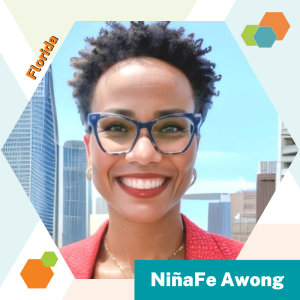As someone who transitioned from industry to the classroom, I understand firsthand the challenges alternatively certified instructors face when they are expected to translate technical expertise into effective teaching, often without sufficient pedagogical training or support.
Some people complain about systems while others build solutions. Meet solutions builder Dr. NiñaFe Awong, Director of Special Projects and Innovation, Tallahassee State College – Center for Workforce Development, and a Fellow in the third cohort of the Postsecondary State CTE Leaders Fellowship at Advance CTE – Sponsored by ECMC Foundation.
Q: Let’s start with your journey into CTE. How did your background shape your path into this field?

I continued my CTE journey throughout high school, participating in several programs that allowed me to “test drive” different career paths. While CTE did not dictate what career to pursue, it helped me explore my interests, build real-world skills, and ultimately discover my true path. That exposure to hands-on learning and career exploration laid the foundation for my professional purpose.
I was introduced to Future Business Leaders of America (FBLA) in middle school…It gave me purpose, direction, and the confidence to see my potential, while showing me that education can look different and still be powerful and meaningful.
Over the past decade, I have worked to expand access to high-quality CTE and workforce development programs, especially for learners who benefit from seeing education through a more applied, hands-on lens. Whether serving in CTE leadership roles at the local or state level, my work has remained focused on creating purposeful, career-aligned pathways that equip students with the skills and experiences they need to succeed in tomorrow’s workforce. CTE gave me the confidence to dream bigger, and now I am committed to ensuring every learner has the opportunity to do the same.
Q: You’ve been vocal about the need to explore the perceptions, experiences, and satisfaction levels of alternatively certified instructors. Why do you think this is such a crucial issue?
A: This issue is incredibly close to my heart because I lived it. I transitioned from industry to the classroom, and while I brought a strong foundation of real-world experience, I quickly realized that was not enough. With limited formal support, I had to figure things out independently, learn how to manage a classroom, build lesson plans, and reach students in ways I had not been trained to do. Compared to traditionally trained educators, there were apparent gaps in my pedagogical knowledge, and I felt that deeply.
Thankfully, I had a strong support system and a relentless drive to grow for myself and my students. However, not every alternatively certified instructor has access to that kind of support. Therefore, we risk losing some of our most passionate, experienced educators if we do not address their unique needs.
That is why I have been so vocal about exploring the perceptions, experiences, and satisfaction levels of alternatively certified CTE instructors, because they are the backbone of CTE. Yet, their voices are often absent from the policy and programmatic conversations that shape the field.
Compared to traditionally trained educators, there were apparent gaps in my pedagogical knowledge, and I felt that deeply.
These educators bring invaluable real-world experience from industry into the classroom, bridging the gap between workforce expectations and student preparation. However, many enter teaching without traditional pedagogical training or the support systems certified teachers receive, creating unique challenges related to classroom management, instructional planning, professional identity, and retention.
I have been vocal about this issue because these instructors are often treated as temporary stopgaps rather than valued contributors to the long-term success of CTE programs. If we do not take the time to understand their needs, we risk high turnover, diminished instructional quality, and missed opportunities to truly integrate industry expertise into our education systems.
By listening to their experiences and investing in targeted supports, we improve instructor satisfaction and retention and strengthen students’ learning experience. This is about building sustainable, high-quality CTE programs that reflect the realities of today’s workforce and elevate the people preparing students for it.
Q: You’ve spoken before about the need to develop targeted professional development for alternatively certified instructors. Can you share how this commitment has shaped your leadership and actions in your current role?
A: My commitment to developing targeted professional development for alternatively certified instructors has profoundly shaped my leadership approach and the strategic actions I have taken in my current and previous roles. As someone who transitioned from industry to the classroom, I understand firsthand the challenges alternatively certified instructors face when they are expected to translate technical expertise into effective teaching, often without sufficient pedagogical training or support.
This insight became especially critical while serving as state CTE Director in Florida, where I helped launch the nation’s first applied Artificial Intelligence (AI) program for K–12 and sub-baccalaureate students. We created a vertical pathway to the University of Florida while embedding horizontal AI competencies across Florida’s CTE frameworks. Due to the innovation and rigor of this interdisciplinary program of study, I knew that many instructors could face significant barriers to implementation without intentional, structured support.
In response, I sought approval from executive leadership and secured $499,000 in funding to build a statewide professional development initiative in partnership with the University of Florida. We developed a comprehensive curriculum toolkit and aligned instructional strategies with appropriate assessment practices. Over two years, the program served 18 districts and approximately 100 instructors through a 40-hour immersive bootcamp, eight hours of asynchronous learning, and personalized one-on-one coaching.
Long-term impact begins with understanding the realities of those you serve. Too often, decisions are made far from the classroom or training floor.
This was the first time my division had undertaken a professional development initiative of this magnitude, and it underscored the critical importance of meeting instructors where they are. The success of this work further fueled my passion for the issue. Since then, I have continued conducting research and mentoring others in high-impact design. I even centered my doctoral dissertation on this topic, driven by a belief that when we invest in our instructors, especially those entering from nontraditional pathways, we ultimately invest in the success of every learner they serve.
Q: You’re clearly passionate about creating long-term change. What advice would you give to others who want to make a difference in CTE and postsecondary participation and attainment?
A: If you want to make a lasting difference in CTE and postsecondary participation and attainment, my advice is simple: lead with purpose, stay focused on the needs of students and instructors, maintain close connections with industry, and do not be afraid to do the hard work that lasting change requires.
Long-term impact begins with understanding the realities of those you serve. Too often, decisions are made far from the classroom or training floor. However, real progress happens when the voices of students, educators, and employers shape programs and policies. Take time to listen, build trust, and design solutions that reflect what is happening on the ground.
[E]mbrace discomfort. Systemic change requires challenging the status quo, navigating resistance, and sometimes working without a blueprint.
Be bold in your vision but thoughtful in your execution. When I lead large-scale initiatives, I begin with listening sessions, cross-sector collaboration, and a clear focus on sustainability. You are not just addressing today’s challenges, you are building systems that will support instructors and learners well into the future.
Also, embrace discomfort. Systemic change requires challenging the status quo, navigating resistance, and sometimes working without a blueprint. However, if you stay rooted in your mission and surround yourself with people who share your commitment, you will move the needle. Finally, remember this: progress takes persistence. Celebrate the small wins, invest in people, and never lose sight of the students whose lives are changed because you chose to act.
Q: As a participant in Advance CTE’s National Fellowship, what do you hope to gain from this experience?
A: As a participant in Advance CTE’s National Fellowship, I hope to deepen my understanding of the complex policy, practice, and leadership dynamics that shape postsecondary CTE nationally. While I have had the privilege of leading large-scale initiatives at the local and state levels, I am eager to expand my perspective through collaboration with Fellows from across the country who bring diverse experiences and insights.
I plan to use this experience to strengthen my ability to support instructors, develop innovative programs, and create clear, aligned pathways that lead students from the classroom to meaningful careers.
I also look forward to sharpening my skills in systems thinking, data-driven decision-making, and policy design to more effectively influence sustainable change in CTE programs that serve learners beyond high school. Most importantly, I plan to use this experience to strengthen my ability to support instructors, develop innovative programs, and create clear, aligned pathways that lead students from the classroom to meaningful careers.
This Fellowship is an opportunity to grow as a leader, contribute to a national movement, and ensure that more learners, especially those navigating nontraditional paths, have the tools and support they need to succeed in a rapidly evolving workforce.
NiñaFe’s journey to CTE leadership highlights the power of discovery experienced by learners in CTE programs nationwide and how that experience fuels her passion as a CTE leader. Her insights are just one example of the incredible work being done by the fellows of the Advance CTE National Fellowship. To learn more about NiñaFe and other inspiring leadership fellows, visit the Postsecondary State CTE Leaders Fellowship page, where Fellows amplify the transformative nature of experiential learning and share examples of how dedicated leaders build learner-centered programs to meet industry needs.
Interested in developing your own CTE leadership fellowship in your state?
Request more information via our request form or contact Dr. Kevin R. Johnson Sr. at [email protected].

